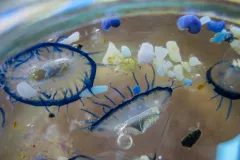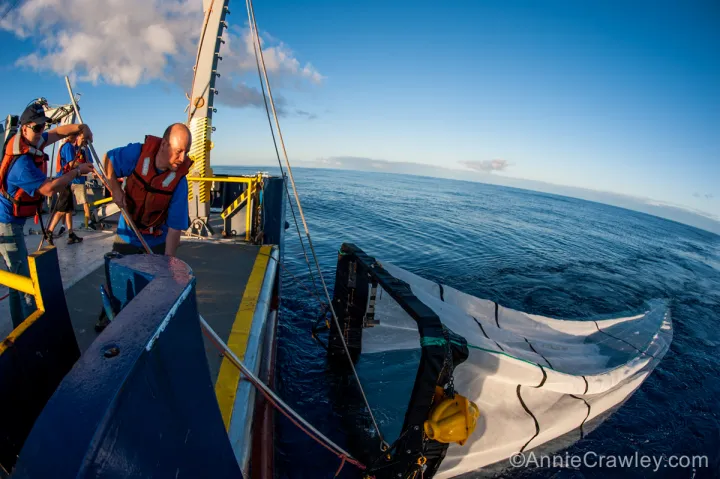Fishing for Plastic: Science in the Great Pacific Garbage Patch

By now, you have probably heard of The Great Pacific Garbage Patch. The name conjures the image of a floating island made of familiar plastic trash such as soda bottles and plastic bags, disposable utensils and lighters. However, this image doesn’t really capture the full spectrum of plastic debris that is out there. While some of the plastic pieces swirling in the Pacific Ocean are large, many of them are closer to the size of a popcorn kernel—and certainly small enough for fish to eat, at least in theory. While we have lots of evidence that sea turtles, seabirds, and marine mammals eat ocean plastic, less is known about plastic eaten by marine fish.
Enter marine ecologists Peter Davison and Rebecca Asch. On their 2009 Scripps Environmental Accumulation of Plastics Expedition (SEAPLEX) to the North Pacific Subtropical Gyre, they collected fish from the mesopelagic layer (aka the twilight zone), where only some filtered sunlight can be found. Thirty to three-hundred feet (10 to 100 meters) below the surface, the twilight zone is sandwiched between the sunny photic zone above and the deep dark ocean below. Approximately 95 percent of the world’s fish inhabit the mesopelagic layer, and a whopping 58 million tons of these fish live in the gyre according to a 1980 count. Many of them migrate to the surface at night to feed and swim to deeper waters to avoid hungry birds during the day. The researchers wanted to know whether these fish were eating plastic from the gyre to better understand the consequences of ocean plastic.
They collected fish with four different nets: hand-held dip nets and manta nets scooped fish at the surface, paired bongo nets captured them 650 feet (200 meters) below the surface, and the Oozeki trawl collected them between 650 and 2,600 feet (200 and 800 meters). As the manta, bongo, and Oozeki nets were towed through the water, marine life and debris were captured, funneled through the net, and into a removable container attached to the end. When the nets were hauled back aboard the research ship, the container was detached and emptied into a bucket to bring the fish back to the lab. In the bucket, they found 141 twilight zone fish representing 27 different species, including big-eyed lanternfish, hatchetfish, and bristlemouths. Peter and Rebecca removed the stomach of each fish and searched for plastic fragments.
In their study published in June 2011, the two scientists found plastic fragments in 9.2 percent of the fish they dissected. As expected, they found more plastic in the bellies of the fish that migrated to the surface (where floating plastic bits are more common) than those fish that remained in the twilight zone. Although 9.2 percent seems like a small amount, consider this fact: based on their findings, fish of the North Pacific Central Gyre have eaten an estimated 12,000 to 24,000 tons of plastic! Because many of these fish live for only one year, Peter and Rebecca believe that figure represents the amount of plastic that Gyre fish eat every single year.
The results of this study indicate that plastic has indeed entered the food chain. While it’s unlikely that we’re ingesting actual plastic fragments when we eat fish, it remains to be seen whether plastic chemicals absorbed by these twilight zone fish are being transferred up the food chain, including to us. And the situation has certainly not improved in the few years since Peter and Rebecca's research; a recent study found that eight million metric tons of plastic waste makes its way into the world’s oceans each year, and that number is on the rise.
Simply stated, our throw-away habits are polluting our food supply. And it won’t get any better until we change. Practice any or all of the following five quick and easy ways to reduce the amount of plastic that makes its way to the ocean:
- Double-check the plastic RECYCLING guidelines in your area. Most types of plastic can be recycled—water bottles; yogurt cups; milk containers; cereal box liners; the stiff plastic packaging we fight to remove from items; shrink wrap; meat trays, etc.
- In restaurants, ask for your leftovers in boxes or wrapped in foil. REFUSE Styrofoam products. Better yet, bring your own container to cart leftovers home. Also, REFUSE a straw when you order a drink.
- REDUCE your single-use plastic consumption by using bar soaps packaged in cardboard or paper instead of liquid soaps that come in plastic bottles, or buy liquid soap in bulk and reuse containers. Whenever you shop, seek out packaging made of compostable material rather than plastic, which is nearly indestructible.
- Bring REUSEABLE bags to the grocery store. Because they're easy to forget when rushing out the door, always keep one or two small ones in your purse or backpack.
- Cut down on those plastic coffee cup lids by bringing a REUSABLE travel mug for your favorite barista to fill. And for water, bring your own bottle filled from the tap.
- And don’t forget about microbeads, tiny plastic beads found in a variety of products that look like fish food. Avoid facial scrubs, soaps and toothpaste with the tiny polyethylene and polypropylene microbeads, which escape water treatment facilities to enter our waterways. If you must exfoliate, look for products that use non-plastic alternatives such as apricot kernel shells and jojoba beads.
 Editor's Note: Patricia Newman and Annie Crawley are the author/photographer team behind Plastic, Ahoy! Investigating the Great Pacific Garbage Patch (Millbrook Press), winner of the Green Earth Book Award, one of the Bank Street College’s Best Books for 2015, a Junior Library Guild Selection, and finalist for the AAAS/Subaru Science Books & Films Prize for Excellence in Science Books. Their goal is to help kids become ocean stewards.
Editor's Note: Patricia Newman and Annie Crawley are the author/photographer team behind Plastic, Ahoy! Investigating the Great Pacific Garbage Patch (Millbrook Press), winner of the Green Earth Book Award, one of the Bank Street College’s Best Books for 2015, a Junior Library Guild Selection, and finalist for the AAAS/Subaru Science Books & Films Prize for Excellence in Science Books. Their goal is to help kids become ocean stewards.


